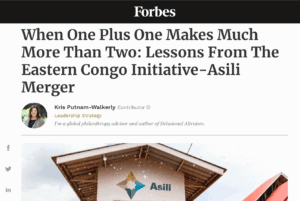
When One Plus One Makes Much More Than Two
By Kris Putnam-Walkerly, global philanthropy advisor and author of Delusional Altruism.
Originally published in Forbes, August 20, 2020

There’s a lot we don’t know about our post-pandemic world. We do know, however, that the societal safety net is straining at the seams as it attempts to meet the needs of the millions who’ve lost their livelihood to the pandemic’s economic fallout.
In this world of hurt, it might be time for philanthropic organizations to seek like-minded giving programs. The goal: Do more to ease increasingly serious community challenges by combining philanthropic energy and resources.
For inspiration and example, take the recent merger between two organizations striving to eliminate persistent poverty in the Democratic Republic of the Congo.

Eastern Congo Initiative (ECI), founded by Ben Affleck and Whitney Williams, brings change via collaborative grantmaking, international advocacy, and policy leadership. Asili, operated by residents of the Kabare region, is a community run business that serves as a platform for self-sufficient Congolese businesses. The platform was designed by the Kabare region residents, Alight (formerly the American Refugee Committee), and IDEO.org.
ECI Executive Director Abraham Leno said while mergers between international organizations are not common, the merger with Asili will be worth the work.
“We can be co-creators of more impactful ways to help our communities,” he said. “We can do more and be in more places, building on what we have done.”
There’s no question mergers are challenging work, whether its philanthropic organizations merging with peers or merging with social enterprises. Successful collaborations and potential mergers take extensive due diligence, patience, and perseverance. More than that, it takes like-minded organizations willing to relinquish autonomy.
The ECI-Asili merger, while still a work in progress, offers a useful perspective for any philanthropy that sees an opportunity to have more impact:
Know Your Why
The Chicago Nonprofit Merger Research Project, which analyzed 25 non-profit mergers between 2004-2014, concluded lack of strategy or strategic intent appeared to be the one factor derailing even the most promising of potential non-profit mergers. ECI and Asili’s one “why” is their commitment to helping Congolese people lift themselves out of persistent poverty. “That’s why we have been so successful,” notes ECI co-founder Whitney Williams, “we follow the brilliance and commitment of the Congolese people.” The other “why” is the opportunity to drive a social enterprise model based on an integrated approach that combines advocacy, building markets, social enterprise, and grantmaking.
Tackle Issues of Turf and Territory
ECI’s Leno said his experience with international non-governmental organizations is that many NGOs are territorial. Their leadership is reluctant to relinquish sole operating power, prestige, and service.
So, yes, collaborating or merging with other organizations will change logistics. Yes, a merged organization means expanding your board and team and welcoming new voices and perspectives. And yes, an expanded board might need to meet more frequently to make the most of additional resources and needs.
Resist the natural urge to focus on what your organization might lose and refocus your energy on how much more a combined force can do for the people served by the charitable organizations you support.
Pick the Right Partner(s)
The ECI-Asili merger is grounded on strong shared foundations. Both are longstanding, respected members of the Congolese philanthropic and business community. They serve the same geographic markets and under common operating rules.
More importantly – and core to what makes ECI and Asili stand out – is a shared commitment to operating as a business centered on the human part of humanitarian effort. The combined organization places a premium on philanthropy that supports self-sufficient business, or what Leno calls ethical commerce.

He points to the Nespresso Partnership as an example. Asili partners with Nespresso and coffee farmers in the Eastern Congo to offer a special single-origin coffee grown from USDA certified organic beans grown by farming families. The initiative is intended to help restore Congo’s coffee sector as the region and industry recover from the impact of years of armed conflict. As part of the partnership, Nespresso is investing $1.2 million to help fund water and healthcare infrastructure in the farming families’ region.
ECI and Asili also share a commitment to evaluating beneficiary organizations on how well those organizations collaborate with community peers and partners.
Interestingly, the COVID-19 pandemic has been on-the-ground training for intra-organization collaboration, Leno said. The pandemic required organizations to put aside individual organizational goals and bring a laser focus on common, urgent, and immediate community challenges.
“We should always be asking, ‘What is changing that we can all be a part of?’” he said.
We are in a changing world that will continue to ask more of philanthropies, nonprofits and businesses focused on corporate responsibility. As I’ve said before, the bigger you think, the more impact you’ll have. Granted, growing through formal collaboration or merger and acquisition isn’t the solution for every philanthropic organization. But philanthropic leaders’ big thinking list should at least list merger and acquisition as a means to grow the organization and dramatically scale your impact.
